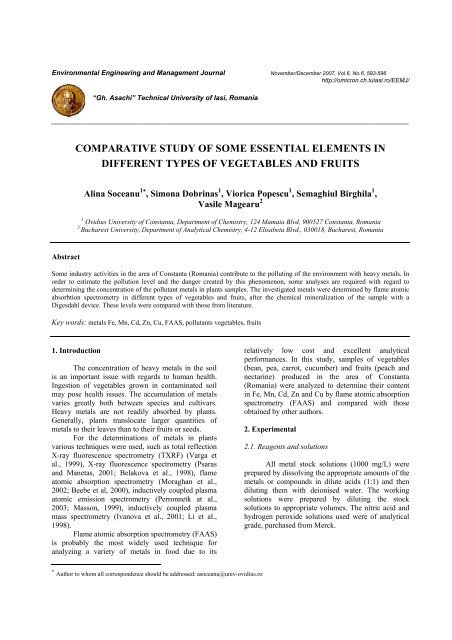2007_6_Nr6_EEMJ
You also want an ePaper? Increase the reach of your titles
YUMPU automatically turns print PDFs into web optimized ePapers that Google loves.
Environmental Engineering and Management Journal November/December <strong>2007</strong>, Vol.6, No.6, 593-596<br />
http://omicron.ch.tuiasi.ro/<strong>EEMJ</strong>/<br />
“Gh. Asachi” Technical University of Iasi, Romania<br />
______________________________________________________________________________________________<br />
COMPARATIVE STUDY OF SOME ESSENTIAL ELEMENTS IN<br />
DIFFERENT TYPES OF VEGETABLES AND FRUITS<br />
Alina Soceanu 1∗ , Simona Dobrinas 1 , Viorica Popescu 1 , Semaghiul Birghila 1 ,<br />
Vasile Magearu 2<br />
1 Ovidius University of Constanta, Department of Chemistry, 124 Mamaia Blvd, 900527 Constanta, Romania<br />
2<br />
Bucharest University, Department of Analytical Chemistry, 4-12 Elisabeta Blvd., 030018, Bucharest, Romania<br />
Abstract<br />
Some industry activities in the area of Constanta (Romania) contribute to the polluting of the environment with heavy metals. In<br />
order to estimate the pollution level and the danger created by this phenomenon, some analyses are required with regard to<br />
determining the concentration of the pollutant metals in plants samples. The investigated metals were determined by flame atomic<br />
absorbtion spectrometry in different types of vegetables and fruits, after the chemical mineralization of the sample with a<br />
Digesdahl device. These levels were compared with those from literature.<br />
Key words: metals Fe, Mn, Cd, Zn, Cu, FAAS, pollutants vegetables, fruits<br />
1. Introduction<br />
The concentration of heavy metals in the soil<br />
is an important issue with regards to human health.<br />
Ingestion of vegetables grown in contaminated soil<br />
may pose health issues. The accumulation of metals<br />
varies greatly both between species and cultivars.<br />
Heavy metals are not readily absorbed by plants.<br />
Generally, plants translocate larger quantities of<br />
metals to their leaves than to their fruits or seeds.<br />
For the determinations of metals in plants<br />
various techniques were used, such as total reflection<br />
X-ray fluorescence spectrometry (TXRF) (Varga et<br />
al., 1999), X-ray fluorescence spectrometry (Psaras<br />
and Manetas, 2001; Belakova et al., 1998), flame<br />
atomic absorption spectrometry (Moraghan et al.,<br />
2002; Beebe et al, 2000), inductively coupled plasma<br />
atomic emission spectrometry (Perronnetk at al.,<br />
2003; Masson, 1999), inductively coupled plasma<br />
mass spectrometry (Ivanova et al., 2001; Li et al.,<br />
1998).<br />
Flame atomic absorption spectrometry (FAAS)<br />
is probably the most widely used technique for<br />
analyzing a variety of metals in food due to its<br />
relatively low cost and excellent analytical<br />
performances. In this study, samples of vegetables<br />
(bean, pea, carrot, cucumber) and fruits (peach and<br />
nectarine) produced in the area of Constanta<br />
(Romania) were analyzed to determine their content<br />
in Fe, Mn, Cd, Zn and Cu by flame atomic absorption<br />
spectrometry (FAAS) and compared with those<br />
obtained by other authors.<br />
2. Experimental<br />
2.1. Reagents and solutions<br />
All metal stock solutions (1000 mg/L) were<br />
prepared by dissolving the appropriate amounts of the<br />
metals or compounds in dilute acids (1:1) and then<br />
diluting them with deionised water. The working<br />
solutions were prepared by diluting the stock<br />
solutions to appropriate volumes. The nitric acid and<br />
hydrogen peroxide solutions used were of analytical<br />
grade, purchased from Merck.<br />
∗ Author to whom all correspondence should be addressed: asoceanu@univ-ovidius.ro


